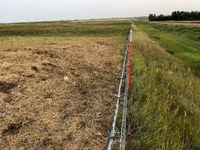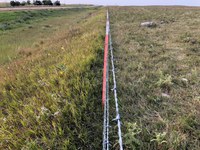Determine Available Forage for Grazing
(Click an image below to view a high-resolution image that can be downloaded)
Returning drought conditions because of hot, dry weather in August and the lingering effects of the 2017 drought have many North Dakota producers concerned about whether their forage resources will last.
“Of immediate concern is how much longer can pastures be grazed,” says Miranda Meehan, North Dakota State University Extension livestock environmental stewardship specialist. “This will vary from ranch to ranch, depending on factors such as growing conditions last year, grazing history and, of course, stocking rate.”
To answer this question, producers will need to determine the available forage for grazing.
The most accurate method to determine available forage or current carrying capacity is the clip and weigh method, according to Meehan. To use this method, producers would clip 5 to 15 frames (1.92 feet squared) of forage and dry and weigh it using a gram scale. Then they should average the weights and multiply by 50 to calculate the pounds per acre. Next, they should multiple by the acres in the pasture to determine the quantity of forage.
“However, this is not the available forage, as we need to account for trampling and waste (25 percent), while ensuring we are leaving enough material to maintain plant health (50 percent),” says Kevin Sedivec, NDSU Extension rangeland management specialist. “This leaves us with 25 percent of the forage for livestock consumption.
“We would then need to divide this by the amount of forage required by the livestock grazing the area,” he adds. “For example, a 1,000-pound cow with a calf consumes 913 pounds of forage per month.”
The NDSU Grazing Calculator App (https://tinyurl.com/Google-NDSUgrazingapp) can help with these calculations. Producers also can use a visual assessment method to estimate utilization, although this method is subject to user bias, Sedivec notes.
The recommended utilization level for forage is 40 to 60 percent. At this level, rangeland utilization is fairly uniform, with 65 to 80 percent of the height of desirable forage species being grazed. Livestock should be removed when this level is exceeded. When you exceed this level, desirable forage species will be cropped closely, removing more than 80 percent of the plant height, and livestock will begin consuming low-quality species.
If producers have an ungrazed area adjacent to the grazing unit with similar forage species, they can use a grazing monitoring stick to determine utilization. Here are the steps for using the grazing monitoring stick:
- Calculate the percent of the plant height removed by dividing the grazed height of the plant by the ungrazed height. Subtract this amount from 1.
- Multiply this amount by 100 to determine the percent of height removed.
- Correlate this number with those in the chart in the NDSU Extension publication “The North Dakota Grazing Monitoring Stick: A Way to Measure Range and Pasture Utilization” (http://tinyurl.com/NDSUGrazingStick) to estimate the percent of entire plant weight removed.
A general rule of thumb is to target 50 percent utilization by weight during a grazing period, as well as at the end of the grazing season. If greater than 50 percent utilization occurs during a grazing period, plant recovery will be slower, which means plants require a longer recovery period between grazing events to maintain their health.
“If pastures were grazed closely or heavily, they must be given adequate time to recover from the added grazing pressure,” Meehan advises. “As you plan for the 2019 grazing season, plan to delay turnout in these pastures.”
Here are additional resources to help determine available forage and utilization:
- ""NDSU Extension Range and Forage Production Sample Kits"" (https://tinyurl.com/NDSU-RangeSampleKits)
- ""Determining Carrying Capacity and Stocking Rates for Range and Pasture in North Dakota"" (http://tinyurl.com/CarryingCapacityStockingRates)
For more assistance, contact your Extension agriculture and natural resources agent.
NDSU Agriculture Communication - Aug. 23, 2018
| Source: | Miranda Meehan, 701-231-7683, miranda.meehan@ndsu.edu |
|---|---|
| Source: | Kevin Sedivec, 701-424-3606, kevin.sedivec@ndsu.edu |
| Editor: | Ellen Crawford, 701-231-5391, ellen.crawford@ndsu.edu |



